Lohagad Fort
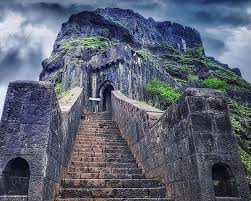
Lohagad Fort, meaning “Iron Fort,” is one of Maharashtra’s most formidable and well-preserved forts, standing at 3,389 feet in the Sahyadri range. Built over 2,000 years ago, this fort was a key stronghold for several dynasties, including the Satavahanas, Chalukyas, Rashtrakutas, Yadavas, Bahamanis, Mughals, and Marathas. It was later recaptured by Chhatrapati Shivaji Maharaj in 1648, becoming a crucial part of his empire.
Located just 52 km from Pune and 11 km from Lonavala, Lohagad is a popular trekking destination, offering breathtaking views, lush greenery, and ancient architecture. The easier trekking route makes it perfect for beginners and adventure lovers alike. One of its main attractions is the famous Vinchu Kada (Scorpion’s Tail), a long, curved extension of the fort.
Whether you’re a history buff, nature enthusiast, or adventure seeker, Lohagad Fort offers a perfect blend of history, nature, and trekking excitement.
Historical Significance
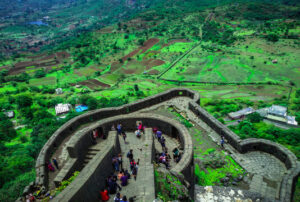
Lohagad Fort has witnessed the rise and fall of various dynasties over 2,000 years, making it one of Maharashtra’s most historically significant forts. Initially built during the Satavahana Dynasty, it was later occupied by the Chalukyas, Rashtrakutas, Yadavas, Bahamanis, Nizamshahi, and Adilshahi rulers before coming under the control of the Mughals. However, it was Chhatrapati Shivaji Maharaj who recaptured the fort in 1648 and later used it as a strategic stronghold and treasury, where he stored the vast wealth looted from Surat. Even after his reign, the fort remained under the Peshwas, playing a crucial role in regional politics before being seized by the British in 1818 during the Third Anglo-Maratha War.
Lohagad Fort served as a key military base due to its strategic location along the trade routes of the Deccan Plateau. It provided defensive advantages, enabling rulers to monitor and control trade movement while protecting surrounding territories. The massive stone walls, strong gateways, fortified bastions, and intelligent architectural design made it nearly impenetrable, ensuring its dominance over centuries.
The fort also played an important role during the Maratha-Mughal conflicts and witnessed numerous battles between these two powerful empires. It was an essential garrison and logistical base for the Marathas, and its control often determined the balance of power in the region.
Apart from its military significance, Lohagad Fort also showcases remarkable architectural elements, such as intricately carved doors, secret escape routes, hidden chambers, and expansive water reservoirs, highlighting the ingenuity of medieval fort construction. The four main gates—Ganesh Darwaja, Narayan Darwaja, Hanuman Darwaja, and Maha Darwaja—are prime examples of Maratha military architecture.
Despite changing hands multiple times, Lohagad remained a symbol of power, resilience, and strategic importance. Today, the fort stands as a historical marvel, attracting history buffs, trekkers, and nature lovers eager to explore its glorious past and breathtaking landscape.
Trekking to Lohagad Fort
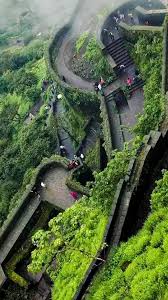
Lohagad Fort is among the most accessible and beginner-friendly treks in Maharashtra. The trek is approximately 5 km from the base village, Bhaje, and offers a delightful blend of natural beauty, historical significance, and adventure. With its well-paved route, ancient stone staircases, and lush green trails, this trek is ideal for both beginners and experienced trekkers.
Trekking Route:
- Starting Point – Malavli Railway Station: The journey begins at Malavli, which is well-connected to Pune and Mumbai via local trains. Many trekkers choose to walk from the station, enjoying the scenic landscapes along the way.
- Bhaje Caves: En route, you can explore the ancient Buddhist rock-cut caves dating back to 200 BCE. These caves, known for their intricate carvings and stupas, are a major attraction.
- Lohagadwadi – The Base Village: This small yet vibrant village marks the official starting point of the trek. Here, you can find local food stalls, small shops, and resting points to prepare for the climb.
- Lohagad Fort Entrance: A grand entrance welcomes trekkers after climbing 300+ well-maintained stone steps, leading to the main fort area.
Trek Duration and Difficulty
The trek takes approximately 1.5 to 2 hours from the base village, depending on pace and weather conditions. The route is relatively easy, making it a great option for families, beginners, and solo travelers. The final ascent through the fort’s entrance offers a breathtaking view of the Sahyadri ranges.
Best Time for Trekking
- Monsoon (June to September): The best time to visit, as the entire landscape turns lush green with gushing waterfalls, mist-covered trails, and cool weather, creating a magical trekking experience. However, the steps can be slippery, so caution is advised.
- Winter (October to February): Offers pleasant weather, making it ideal for exploring the fort’s history and enjoying panoramic views.
- Summer (March to May): While the trek is still doable, it’s best to start early in the morning to avoid the heat.
Additional Trekking Tips:
- Wear sturdy trekking shoes for better grip, especially during monsoon.
- Carry enough water and energy snacks, as shops are limited after the base village.
- Start early in the morning to avoid crowds and enjoy a peaceful trek.
- Respect nature and heritage—avoid littering and preserve the beauty of the fort.
Whether you’re an adventure seeker, history lover, or nature enthusiast, trekking to Lohagad Fort is an experience that combines thrill, heritage, and scenic beauty in a single journey
Major Attractions at Lohagad Fort
Lohagad Fort is famous for its massive gates, bastions, and stunning viewpoints. Some of the key attractions include:
1. Ganesh Darwaja
The first gate of the fort, adorned with intricate carvings and solid stone structures, welcomes visitors inside this majestic stronghold.
2. Narayan Darwaja, Hanuman Darwaja & Maha Darwaja
These grand gates, built by different rulers, are a testament to the fort’s robust military architecture.
3. Vinchu Kada (Scorpion’s Tail)
A natural rock formation resembling a scorpion’s tail, Vinchu Kada extends from the fort’s main structure. The breathtaking panoramic views from here make it one of the most photogenic spots at Lohagad.
4. Laxmi Kothi
This historical chamber was once used to store treasures and valuable loot during Shivaji Maharaj’s reign.
5. Water Tanks & Canons
Scattered across the fort, these ancient water tanks and old rusted canons give insights into its military past.
6. Hidden Caves and Secret Passages
The fort also has hidden caves and underground pathways, which were likely used for storage and as escape routes in times of war.
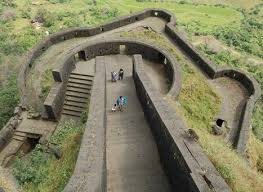
Best Time to Visit
Lohagad Fort is a year-round destination, but each season offers a unique experience, catering to different types of travelers and trekking enthusiasts.
Monsoon (June – September):
The best time to visit, as the fort is transformed into a lush green paradise. The surroundings come alive with cascading waterfalls, mist-covered hills, and cool breezes, making the trek a truly magical experience. However, the steps and trails can be slippery, so it is advisable to wear proper trekking shoes and proceed with caution. If you love monsoon treks, this is the perfect season to explore Lohagad Fort.
Winter (October – February):
A great season for comfortable trekking and sightseeing. The cool and crisp weather makes it ideal for long explorations around the fort, allowing visitors to appreciate its architectural beauty and historical significance. The clear skies also offer stunning panoramic views of the Sahyadri ranges and nearby attractions like Pawna Lake.
Summer (March – May):
While summer is not the most preferred season, early morning and late evening treks can still be enjoyable. The afternoons can be hot and humid, making it uncomfortable for trekking. If visiting during this time, it’s best to start before sunrise, wear light and breathable clothing, and carry enough water to stay hydrated.
Additional Tips for the Best Experience:
- Early morning visits (before 8 AM) ensure less crowd, cooler temperatures, and stunning sunrise views.
- Weekdays are better than weekends if you want a peaceful trekking experience.
- Carry rain protection (raincoats, waterproof bags) if visiting during monsoon.
- Photographers and nature lovers will find monsoon and winter the best seasons for capturing breathtaking landscapes.
No matter the season, Lohagad Fort offers a memorable and adventurous experience, making it one of the best trekking destinations in Maharashtra.
How to Reach Lohagad Fort
Lohagad Fort is well-connected by road, rail, and public transport, making it easily accessible for travelers from Pune, Mumbai, and nearby regions.
By Train:
- Board a local train from Pune to Malavli Railway Station, which is the nearest railhead to Lohagad Fort.
- From Malavli, you can either trek 5 km to the base village or hire a shared auto-rickshaw or cab to Lohagadwadi, the starting point of the trek.
- If coming from Mumbai, take a train to Lonavala, then board a local train to Malavli or hire a taxi from Lonavala.
By Road:
- From Pune (52 km): Drive via the Old Mumbai-Pune Highway (NH 48), taking a detour at Malavli.
- From Mumbai (100 km): Travel via Lonavala, then take the internal roads towards Bhaje Village and Lohagadwadi.
- Parking is available near the base village, but roads can be narrow and crowded on weekends.
By Bus:
- State transport buses operate between Pune, Lonavala, and Malavli.
- From Lonavala, you can take a bus or shared taxi to Malavli, followed by a trek or rickshaw ride to the base.
Alternative Route:
For those seeking a longer and more scenic trek, you can start from Bhaja Caves and follow the trail leading to the fort. This route offers stunning views and a chance to explore the ancient Buddhist rock-cut caves along the way.
Travel Tips:
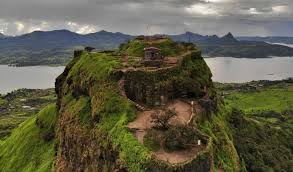
- If visiting during peak monsoon season, be prepared for traffic congestion and muddy roads.
- Plan an early morning trip to avoid crowds and experience a peaceful trek.
- Carry cash, as digital payments might not be accepted in remote areas.
No matter which route you choose, the journey to Lohagad Fort is as exciting as the destination itself, offering breathtaking landscapes and a thrilling trekking experience.
Trekking Tips for Lohagad Fort
To ensure a safe and enjoyable trek, keep the following tips in mind:
- Wear good trekking shoes for grip on rocky surfaces.
- Carry enough water (at least 2 liters) as there are limited drinking water sources on the trek.
- Start early in the morning to enjoy sunrise views and avoid crowds.
- Carry light snacks, energy bars, and ORS to stay hydrated and energized.
- Respect nature and heritage by avoiding littering and damaging historical structures.
- Check the weather forecast before trekking, especially during monsoons.
- Bring a raincoat or waterproof jacket if trekking in the rainy season.
Nearby Attractions
If you have extra time, explore these must-visit attractions near Lohagad Fort that offer history, adventure, and natural beauty:
1. Visapur Fort (2 km)
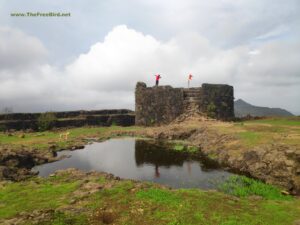
Located adjacent to Lohagad, Visapur Fort is a larger and more challenging trek. The fort’s massive walls, water reservoirs, and stunning hilltop views make it a paradise for adventure seekers. The monsoon season enhances its charm with mist-covered trails and waterfalls.
2. Bhaje Caves & Karla Caves (5 km)
These ancient Buddhist rock-cut caves, dating back to 200 BCE, feature intricate carvings, stupas, and prayer halls. The Bhaje Caves are closer to Lohagad and can be explored before starting the trek. Karla Caves, famous for the Ekvira Devi Temple, are a short drive away.
3. Pawna Lake (12 km)
A tranquil escape, ideal for camping, boating, and photography. This artificial lake offers breathtaking sunset views, making it a perfect spot for relaxation after a trek.
4. Ekvira Devi Temple (10 km)
Located near Karla Caves, this temple is dedicated to Goddess Ekvira and is an important pilgrimage site. Thousands of devotees visit during Navratri. The hilltop location provides a panoramic view of the valley.
5. Tikona Fort (20 km)

A pyramidal-shaped hill fort, offering an easy yet rewarding trek with 360-degree views of the Sahyadri ranges and Pawna Lake. The stone-carved steps and ancient ruins add to its historical charm.
6. Bedse Caves (15 km)
A lesser-known yet stunning Buddhist cave complex, offering serene surroundings and intricate carvings. These caves provide a peaceful retreat away from the usual crowd.
7. Kune Waterfalls (25 km)
One of the highest waterfalls in Maharashtra, cascading from a height of 200 meters. It’s an ideal spot for nature lovers and photographers, especially during monsoon.
8. Lonavala & Khandala (15 km)
The famous hill stations of Lonavala and Khandala offer scenic viewpoints, chikki shops, and beautiful waterfalls. Must-visit spots include Tiger’s Leap, Bhushi Dam, and Duke’s Nose.
Exploring these nearby attractions will enhance your trip to Lohagad Fort, giving you a mix of trekking, history, spirituality, and relaxation.
Conclusion
Lohagad Fort is a perfect blend of history, nature, and adventure. Whether you’re an experienced trekker, a history enthusiast, or a nature lover, this fort offers an unforgettable experience. The easy trek, breathtaking views, and rich historical legacy make it a must-visit destination in Maharashtra.
The fort’s strategic location, ancient architecture, and serene surroundings transport visitors back in time, offering a glimpse into the glorious past of the Maratha Empire. Every corner of Lohagad tells a story, from its majestic gateways to the iconic Vinchu Kada (Scorpion’s Tail).
For those seeking an adventure-filled getaway from Pune or Mumbai, Lohagad Fort is the perfect choice. Whether you visit during the monsoon to witness its lush greenery, in winter for a refreshing trek, or in summer for a historical exploration, this fort guarantees an enriching and memorable experience.
So, gather your friends and family, lace up your trekking shoes, and embark on an incredible journey to conquer the mighty Iron Fortress of Maharashtra.

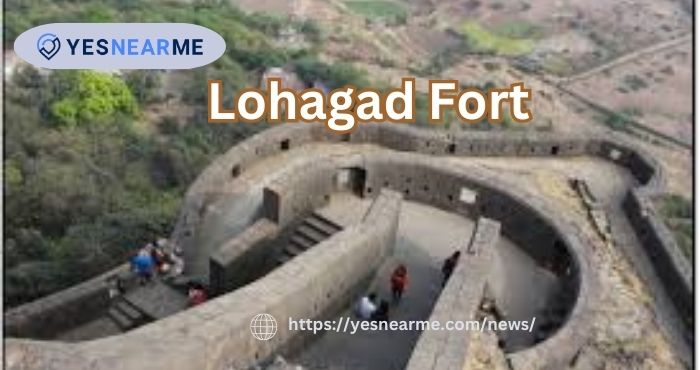




Trackbacks/Pingbacks